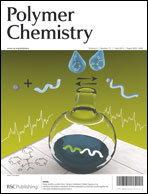We investigated the molecular aggregation states, mechanical properties, and biodegradability of environmentally benign segmented polyurethane(urea)s [SPU(U)s], which contained bio-based monomers of an α-amino acid lysine-based diisocyanate (LDI). The SPU(U)s consisted of an aliphatic diisocyanate (LDI or 1,4-butanediisocyanate (BDI)), a chain extender (1,4-butanediamine (BDA) or 1,4-butanediol (BDO)), and a poly-ε-caprolactone (PCL) segment. Four SPU(U)s, LDI–BDA, LDI–BDO, BDI–BDA, and BDI–BDO, were prepared by a standard two-step prepolymer method. Fourier transformed infrared spectroscopy (FT-IR), differential scanning calorimetry (DSC), dynamic mechanical analysis (DMA), and small-angle X-ray scattering (SAXS) measurement indicated that the LDI-series SPU(U)s formed weakly aggregated hard segment domains, which readily dissociated under mechanical deformation and heating. The diamine chain extender, BDA, enhanced the stability of the hard segment domains, and the BDA-series SPU(U)s exhibited better mechanical properties than the BDO-series. The LDI-series SPU(U)s have notable biodegradability, and the BDI-based hard segments delayed the degradation rate because of the strongly segregated hard segment.


 Please wait while we load your content...
Please wait while we load your content...